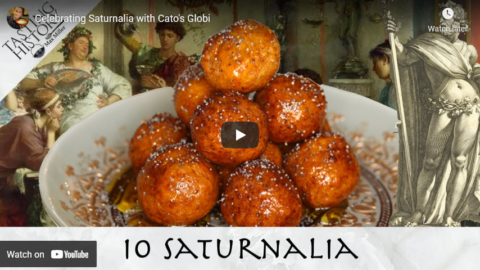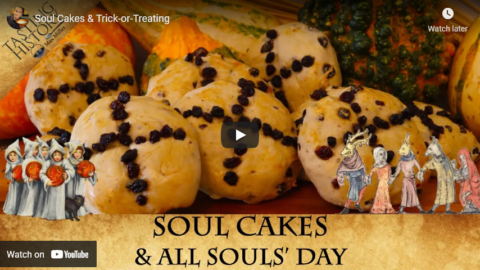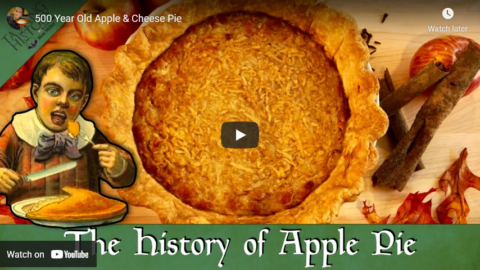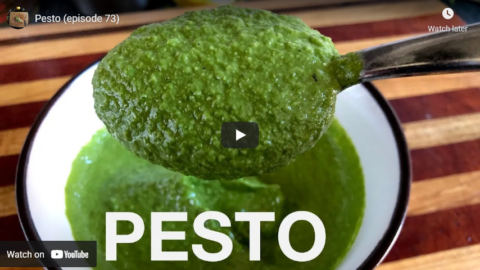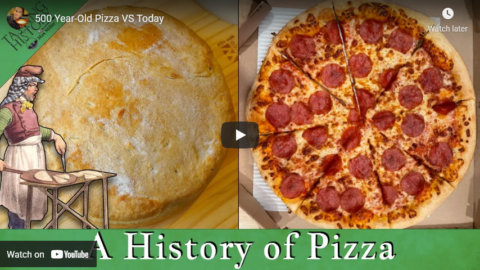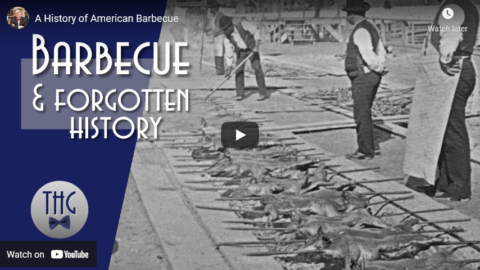Tasting History with Max Miller
Published 9 Feb 2021Help Support the Channel with Patreon: https://www.patreon.com/tastinghistory
Tasting History Merchandise: crowdmade.com/collections/tastinghistoryFollow Tasting History here:
Instagram: https://www.instagram.com/tastinghist…
Twitter: https://twitter.com/TastingHistory1
Tiktok: TastingHistory
Reddit: r/TastingHistory
Discord: https://discord.gg/d7nbEpyTasting History’s Amazon Wish List: https://amzn.to/3i0mwGt
LINKS TO INGREDIENTS & EQUIPMENT**
Sony Alpha 7C Camera: https://amzn.to/2MQbNTK
Sigma 24-70mm f/2.8 Lens: https://amzn.to/35tjyoW
Glutinous Rice Flour: https://amzn.to/3cxbdFd
Dried Bamboo Leaves: https://amzn.to/3ama0xT
Roast Chestnuts: https://amzn.to/3tc3emZ
Dried Jujubes: https://amzn.to/3aqBrqkLINKS TO SOURCES**
The Annals of Lü Buwei: https://amzn.to/3rfbjFM
Chinese Fairy Tales and Legends by Frederick Martens: https://amzn.to/39BqwLe
Chinese Mythology by Matt Clayton: https://amzn.to/3j6pxpv**Amazon offers a small commission on products sold through their affiliate links, so each purchase made from this link, whether this product or another, will help to support this channel with no additional cost to you.
Subtitles & Ketchup with Max host: Jose Mendoza
PHOTO CREDITS
Pig: By Made by Fanghong – Own work, CC BY 2.5, https://commons.wikimedia.org/w/index…
Rat and Ox: D.h.Isais, CC BY-SA 4.0 https://creativecommons.org/licenses/…, via Wikimedia Commons
Chinese Zodiac Carving: By Jakub Hałun – Own work, CC BY-SA 4.0, https://commons.wikimedia.org/w/index…
Guangdong Niangao: avlxyz from (optional), CC BY-SA 2.0 https://creativecommons.org/licenses/…, via Wikimedia Commons
Hong Kong niangao: Mk2010, CC BY-SA 3.0 https://creativecommons.org/licenses/…, via Wikimedia Commons
Niangao from local Hong Kong: Geoffreyrabbit, CC BY-SA 4.0 https://creativecommons.org/licenses/…, via Wikimedia Commons
Nian gao 2: ProjectManhattan, CC BY-SA 3.0 https://creativecommons.org/licenses/…, via Wikimedia Commons
Chinese New Year Sticky Rice Cakes: ProjectManhattan, CC BY-SA 3.0 https://creativecommons.org/licenses/…, via Wikimedia Commons
Spring and Autumn Period Map: By Yug – Own work, *Background data: ETOPO1 + QGIS > then vectorized using Inkscape *Semantic data: some from Le Monde Chinois, Gernet, p58.or (en:) Gernet (1996) A History of Chinese Civilisation, Cambridge university press, p. 59, CC BY-SA 3.0, https://commons.wikimedia.org/w/index…
Statue of Wu Zixu: By Peter Potrowl – Own work, CC BY 3.0, https://commons.wikimedia.org/w/index…
Bronze DIng: drs2biz, CC BY-SA 2.0 https://creativecommons.org/licenses/…, via Wikimedia Commons
Great Wall at Mutianyu: By J. Samuel Burner – https://www.flickr.com/photos/lobster…, CC BY 2.0, https://commons.wikimedia.org/w/index…MUSIC CREDITS
Music promoted by 1HMNC – No Copyright Music
PeriTune – Folk Chinese https://youtu.be/_FKFunLPksg Folk Chinese by PeriTune (https://soundcloud.com/sei_peridot) is licensed under a Creative Commons License.(CC BY 3.0)#tastinghistory #niangao #chinesenewyear #chinesefood
February 1, 2022
Ancient Nian Gao | Lunar New Year Cake
December 31, 2021
Hogmanay Shortbread from 1779
Tasting History with Max Miller
Published 28 Dec 2021Use my exclusive link here https://cen.yt/TastingHistory5 to get $15 off your first three bags.
Support the Channel with Patreon ► https://www.patreon.com/tastinghistory
Merch ► crowdmade.com/collections/tastinghistory
Instagram ► https://www.instagram.com/tastinghist…
Twitter ► https://twitter.com/TastingHistory1
Tiktok ► TastingHistory
Reddit ► r/TastingHistory
Discord ► https://discord.gg/d7nbEpy
Amazon Wish List ► https://amzn.to/3i0mwGtSend mail to:
Tasting History
PO Box 766
Burbank, CA 91503LINKS TO SOURCES**
Cookery, and Pastry, as Taught and Practised by Mrs Maciver by Susanna Maciver: https://amzn.to/3EmSPcm
The Little Book of Hogmanay by Bob Pegg: https://amzn.to/30RAmqO**Some of the links and other products that appear on this video are from companies which Tasting History will earn an affiliate commission or referral bonus. Each purchase made from these links will help to support this channel with no additional cost to you. The content in this video is accurate as of the posting date. Some of the offers mentioned may no longer be available.
Subtitles: Jose Mendoza | IG @ worldagainstjose
PHOTO CREDITS
Shortbread fingers: Dave Souza – Own work, CC BY-SA 2.5, https://commons.wikimedia.org/w/index…
Black Bun: IMBJR, CC BY-SA 3.0 https://creativecommons.org/licenses/…, via Wikimedia CommonsMUSIC CREDIT
“Achaidh Cheide – Celtic” by Kevin MacLeod is licensed under a Creative Commons Attribution 4.0 license. https://creativecommons.org/licenses/…
Source: http://incompetech.com/music/royalty-…
Artist: http://incompetech.com/#tastinghistory #hogmanay #shortbread
December 27, 2021
Celebrating Saturnalia with Cato’s Globi
Tasting History with Max Miller
Published 15 Dec 2020Help Support the Channel with Patreon: https://www.patreon.com/tastinghistory
Tasting History Merchandise: crowdmade.com/collections/tastinghistoryFollow Tasting History here:
Instagram: https://www.instagram.com/tastinghist…
Twitter: https://twitter.com/TastingHistory1
Reddit: r/TastingHistory
Discord: https://discord.gg/d7nbEpyLINKS TO INGREDIENTS & EQUIPMENT**
Canon EOS M50 Camera: https://amzn.to/3amjvwu
Canon EF 50mm Lens: https://amzn.to/3iCrkB8
Safflower Oil: https://amzn.to/39Lcsiz
Spelt Flour: https://amzn.to/3ggzPBO
Poppy Seeds: https://amzn.to/37DyG3q
Pokemon plushie: www.pokemoncenter.comLINKS TO SOURCES**
De Agricultura by Cato the Elder: https://amzn.to/3qxL5P5
Saturnalia by Macrobius: https://amzn.to/39N6Pkb
The Twelve Ceasars by Seutonius: https://amzn.to/39MQBat
**Amazon offers a small commission on products sold through their affiliate links, so each purchase made from this link, whether this product or another, will help to support this channel with no additional cost to you.Subtitles: Jose Mendoza
GLOBI
ORIGINAL 2ND CENTURY BC RECIPE (From De Agricultura by Cato the Elder)
Globi to be made thus: Mix the cheese and spelt in the same way. Make as many as desired. Pour fat into a hot copper vessel, and fry one or two at a time, turning them frequently with two sticks, and remove when done. Coat with honey, sprinkle with poppy-seeds, and serve.MODERN RECIPE
INGREDIENTS
– 1 Cup (240g) Ricotta Cheese
– 1 Cup and 1 tablespoon (120g) Spelt, Durum or other whole grain flour
– 1 Quart (1 L) of fat or oil
– 1/3 Cup (80ml) Honey
– Poppy SeedsMETHOD
1. Mix the cheese and flour in a large bowl, then form it into balls about 1 inch across. This recipe should make 12-15 balls.
2. Heat the oil over a high heat until it reaches 350°F (175°C). Turn heat to medium and fry two to three balls at a time, turning every 10 to 15 seconds with tongs. At 60 seconds, begin to check the color; once they are a golden brown (60-90 seconds) take them out and set them on a wire rack over paper towels to drain. Repeat until all of the globi are fried.
3. Dip the dried globi in honey (heating the honey can help if it is too thick). Then sprinkle with poppy seeds and serve.PHOTO CREDITS
Saturn: By inconnu – User:Jean-Pol GRANDMONT (2011), CC BY 3.0, https://bit.ly/39OKgLF
A Statue of Chronos: By Rufus46 – Own work, CC BY-SA 3.0, https://bit.ly/3giv9eH
Pileus: By Marie-Lan Nguyen (2009), CC BY 2.5, https://bit.ly/3osYo1l
Roman Collared Slaves: Ashmolean Museum, CC BY-SA 2.0 https://bit.ly/36OoIgz
Candles Oberflacht: Landesmuseum Württemberg, CC BY-SA 3.0 https://bit.ly/2Lf9yZp
Roman Figurines: Carole Raddato from FRANKFURT, Germany, CC BY-SA 2.0 https://creativecommons.org/licenses/…#tastinghistory #saturnalia #globi #romancooking
December 21, 2021
Figgy Pudding | A Victorian Christmas Tradition
Tasting History with Max Miller
Published 1 Dec 2020Help Support the Channel with Patreon: https://www.patreon.com/tastinghistory
Tasting History Merchandise: https://bit.ly/3oLyAhWFollow Tasting History here:
Instagram: https://www.instagram.com/tastinghist…
Twitter: https://twitter.com/TastingHistory1
Reddit: r/TastingHistory
Discord: https://discord.gg/d7nbEpyLINKS TO INGREDIENTS & EQUIPMENT**
Canon EOS M50 Camera: https://amzn.to/3amjvwu
Canon EF 50mm Lens: https://amzn.to/3iCrkB8
Pudding Cloth: https://amzn.to/3nFIvnX
Beef Suet: https://amzn.to/3pN4Xx9
Currants: https://amzn.to/36Rh5ojLINKS TO SOURCES**
Modern Cookery by Eliza Acton: https://amzn.to/2HlVCLA
A Christmas Carol: https://amzn.to/3kNguJp
The Battle for Christmas by Stephen Nissenbaum: https://amzn.to/3kQZ7aq
Household Words: A Weekly Journal, Vol 2 – https://bit.ly/2IuJ2Ke
Good Housekeeping, Volumes 5-6: https://bit.ly/32F2SJS**Amazon offers a small commission on products sold through their affiliate links, so each purchase made from this link, whether this product or another, will help to support this channel with no additional cost to you.
Subtitles: Jose Mendoza
DISH NAME
ORIGINAL 1845 RECIPE (From Modern Cookery for Private Families)
The Author’s Christmas Pudding.
To three ounces of flour, and the same weight of fine, lightly-grated bread-crumbs, add six of beef kidney-suet, chopped small, six of raisins weighed after they are stoned, six of well-cleaned currants, four ounces of minced apples, five of sugar, two of candied orange-rind, half a teaspoonful of nutmeg mixed with pounded mace, a very little salt, a small glass of brandy, and three whole eggs. Mix and beat these ingredients well together, tie them tightly in a thickly floured cloth, and boil them for three hours and a half. We can recommend this as a remarkably light small rich pudding: it may be served with German wine, or punch sauce.MODERN RECIPE
INGREDIENTS
– 3 oz (85g) Flour
– 3 oz (85g) Bread Crumbs
– 6 oz (170g) Beef Suet (Lard or Crisco will work as well)
– 6 oz (170g) stoned Raisins
– 6 oz (170g) Currants
– 4 oz (113g) Minced Apples
– 5 oz (142g) Brown Sugar
– 2 oz (57g) Candied Peel
– ½ teaspoon Nutmeg and mace
– A few grains of Salt
– 3 oz (88ml) Brandy
– 3 EggsMETHOD
1. Boil the pudding cloth for 20 minutes. Then carefully remove it from the pot and lay it out flat. Spread suet, lard or butter across it and rub in a liberal amount of flour.
2. Combine all ingredients in a large bowl and mix. Then form into a ball and place in the middle of the pudding cloth. Gathering the cloth tightly around it, twist the cloth at the “neck” then wrap it with a string several times and tie tightly around it.
3. Boil a large pot of water with an upside down plate on the bottom of the pot. Set the pudding in the boiling water and let boil for 3 1/2 hours. Check often and add more boiling water when necessary.
4. Remove pudding from the water and allow to dry before unwrapping. This can be served right away or aged for several weeks/months.Punch sauce for Sweet Puddings
This may be served with custard, plain bread, and plum-puddings. With two ounces of sugar and a quarter of a pint of water, boil very gently the rind of half a small lemon, and somewhat less of orange-peel, from fifteen to twenty minutes; strain out the rinds, thicken the sauce with an ounce and a half of butter and nearly a teaspoonful of flour, add a half-glass of brandy, the same of white wine, two thirds of a glass of rum, with the juice of half an orange, and rather less of lemon-juice: serve the sauce very hot, but do not allow it to boil after the spirit is stirred in.
– 2oz Sugar
– ¼ pint Water
– Lemon & Orange Rind
– 1 ½ oz Butter
– 1 Teaspoon Flour
– ½ Wineglassful Brandy
– ½ Wineglassful White Wine
– ⅔ Wineglassful Rum
– Orange & Lemon JuiceMUSIC CREDITS
“We Wish You a Merry Christmas” by Twin Musicom is licensed under a Creative Commons Attribution 4.0 license. https://creativecommons.org/licenses/…
Artist: http://www.twinmusicom.org/“Angels We Have Heard – Christmas” by Kevin MacLeod is licensed under a Creative Commons Attribution 4.0 license. https://creativecommons.org/licenses/…
Source: http://incompetech.com/music/royalty-…
Artist: http://incompetech.com/“Rondo for harp” – Mike Harper
#tastinghistory #christmaspudding #figgypudding
November 27, 2021
Making a Medieval TART DE BRY (Brie Tart) | Brie: The King of Cheese
Tasting History with Max Miller
Published 28 Apr 2020This Tart de Bry, or Brie Tart, comes from The Forme of Cury and was served at the table of King Richard II (1367 – 1400). Its flavor is nearly as rich as the history of the cheese that goes into it, and in this episode I will explore both.
Help Support the Channel with Patreon: https://www.patreon.com/tastinghistory
Follow Tasting History with Max Miller:
Instagram: https://www.instagram.com/tastinghist…
Twitter: https://twitter.com/TastingHistory1Episodes mentioned in this video:
Medieval Cheesecake (for tart dough) – https://youtu.be/GCCJ2Qpr1nM
Medieval Cheese (for straining cheese) – https://youtu.be/vlQZ3NPnoLk
Rapé Fig Spread: https://youtu.be/_o7Oq-OjKu8LINK TO INGREDIENTS & TOOLS**
SAFFRON THREADS – https://amzn.to/2yTwoPS
PIE SHIELD – https://amzn.to/2YeTnjh
TART TIN – https://amzn.to/2yPbUrCLINK TO SOURCE:
The Forme of Cury: https://amzn.to/31frAAy**Amazon offers a small commission on products sold through their affiliate links, so each purchase made from this link, whether this product or another, will help to support this channel with no additional cost to you.
TART DE BRY
RECIPE (1390 – The Forme of Cury)
Take a crust ynch depe in a trape. Take yolkes of ayren rawe and chese ruayn and medle it and the yolkes together. And do thereto powdor gynger, sugar, safron and salt. Do it in a trape, bake it, and serve it forth.MODERN RECIPE (Based on Lorna J Sass’s adaptation from To The King’s Taste – https://amzn.to/3bNg2XE)
INGREDIENTS
– 1 pound of Brie cheese, the younger the better
– 6 egg yolks
– ⅛ tsp saffron (about 10 threads ground up)
– ¾ tsp light brown sugar or more if you want a sweeter tart.
– ⅜ teaspoon powdered ginger
– A pinch of salt
– A sprinkle of nutmeg or cinnamon (optional)METHOD
1. Preheat the oven to 425°F / 220°C.
2. Roll out your tart dough to about an ⅛ inch thick and line your tin. Add pie weights and set in the oven to blind bake for 10 minutes. Remove the crust and remove the pie weights. If the bottom of the crust is not fully cooked, return it to the oven without the weights for 5 minutes. Once out of the oven, press down the bottom of the crust if it has risen. Allow crust to cool completely and reduce the oven temperature to 350°F / 175°C.
3. Remove the rind from the brie saving some to the side. Then cut the brie into small pieces and place in a blender with the egg yolks. Blend together. Then add the saffron, brown sugar, ginger, and salt and blend to combine.
4. Place a bit of the rind on the bottom of the tart and add the cheese mixture and smooth the top. If you are using cinnamon or nutmeg, sprinkle a bit on top now.
5. Bake at 350°F / 175°C for 30 to 40 minutes or until the top is set and begins to brown. Serve warm or at room temperature.SOURCES
The Forme of Cury – By Samuel Pegge – https://amzn.to/3cXBycA
To The King’s Taste – Lorna J. Sass – https://amzn.to/3bNg2XE
The Course of History: 10 Meals that Changed the World – https://amzn.to/2yWuIoL
Brie Cheese History – https://www.thespruceeats.com/history…PHOTOS
Abbaye Notre-Dame-de-Jouarre – Fredlesles CC BY-SA (https://creativecommons.org/licenses/…)
By J. Chéreau – Musée de la Révolution française, CC BY-SA 4.0, https://commons.wikimedia.org/w/index…
A carriage underside has broken sending the occupants flying Wellcome / CC BY (https://creativecommons.org/licenses/…)
Blue Stilton – Coyau / Wikimedia Commons / CC BY-SA 3.0
Limberger Cheese – Original photo by John Sullivan
Gruyere – © Rolf Krahl / CC BY (https://creativecommons.org/licenses/…)
Stracchino – Cvezzoli / CC BY-SA (https://creativecommons.org/licenses/…)
Brie cheese with fresh thyme on black background – Marco Verch / CC BY-SA 2.0 (https://flickr.com/photos/160866001@N…)#brie #cheese #medieval #medievalfood #tastinghistory #medievalrecipes
November 15, 2021
Sarah Hoyt on what happens when the wheels come off
In the latest Libertarian Enterprise, Sarah Hoyt considers the supply chain chaos we’re seeing these days and reminisces about what happened in Portugal when the bakers went on strike, disrupting bread deliveries for most of the country:
Let me explain: to some extent this plan is always stupid because humans are resourceful. Even back in the seventies, in Portugal when the bakers kept going on strike (and to understand how much this touched the normal person, you have to understand that back then we were used to getting our bread delivered to the door before we woke up. Tie a bag to the back door, leave a note of what you wanted, wake up to crackling fresh rolls and baguettes. This is one the things I really missed when I moved here. Then I found bread machines, and made do.) The first couple of weeks were pandemonium and people were deeply unhappy because their routine — worse, their waking up routine — was disrupted.
And then things … changed. So, some people started making their own bread. Some people started making their own bread, other people heard and suddenly they were showing up at the back door and placing an order for the morning, then coming in the morning and knocking a certain way to receive your order. It was annoying, but life went on, and not everyone had to bake their own bread anyway.
Oh, and bonus, you didn’t have to pay taxes on the bread you sold. You were obliging your neighbors, and if they wanted to give you some money in return to help with expenses, it would be rude to refuse. (And since everyone was doing it, they couldn’t chase everyone, even in a tiny country.) Oh, and to understand this one, and the reason I use this expense, I don’t think people in Portugal had baked their own bread (Other than farmers making broa [Portuguese cornbread]) since before Roman times. Artisanal bread wasn’t a thing. But people found a way.
I do realize with so much of our manufacturing in China, and the supply problems, etc, it seems like the world is coming down on top of our heads.
But people find a way. Look, in Cuba, a tiny country, they’ve kept 1950s cars going all these decades. They might be repaired with washing machine parts, but they keep going.
The US is a huge country, with a ton more resources, and perhaps genetically (As we’re immigrants or descended thereof) more adaptable people.
We’re in the first shock, so not much being done to get around this cr*p inflicted on us from above. But in a month or two, probably before the anger reaches the level (alas) that #teamheadsonpikes comes out to play, we’ll adapt, improvise, overcome.
People are already buying direct from farmers. I have no idea how the Christmas gift shopping is going, because since the kids haven’t been little, we usually pick ONE interesting or meaningful thing for them, and anyway, Dan and I always want the same “A book and a music-vehicle (used to be a CD)”. This year, with worry over selling the house, etc. I haven’t even looked. I keep hearing it will be lean, but I suspect Americans will make more stuff/etsy will have a boom year. And life will move on. Heck, I know someone considering going into 3D printing to make those pieces that are stuck in containers or that China is not sending off, or whatever, to repair your car/washing machine/air conditioning. Yeah, copyright problems, but if you market it as a “Stop gap while you wait” and market to local repairmen? I bet it works.
The point is we’re not Portuguese or Cubans. Not a small country, easily stomped. Out in the heartland, people will go over, go under, get around almost by default.
November 5, 2021
Easy Homemade Chilli Ketchup – Tastes amazing!
ChilliChump
Published 31 Aug 2018In this video I show you my recipe to make your own chilli ketchup! (If you want plain ketchup without the spice then you can leave out the birds eye peppers. At the same time if you want it hotter then add more peppers … or hotter peppers!)
Making your OWN ketchup means you get to control what goes into it … so if you want to reduce the amount of sugar in your diet, but still want to enjoy ketchup, then make your own! Plus this just tastes incredible!
Smoker box: http://geni.us/bbqsmoker
Squeeze Bottles: https://amzn.to/2HOgjyb
Slow Cooker: http://geni.us/slowcook (not the exact one I have, because mine is quite old. But this is a decent one)
Hand blender: http://geni.us/handblendIngredients:
1.2 KG Plum Tomatoes
3 Tins plum tomatoes(or another 1.2KG of fresh plum tomatoes)
6 Jalapenos (4 red, 2 green)
25-30 Birds Eye Chillis
2x Red Onions
8 Cloves of Garlic
Piece of Ginger (a bit smaller than golf ball sized)
Piece of Fresh Fennel (about half a fennel bulb)
3x Celery sticks
1 tbsp Dried Coriander Seeds
1 tbsp Pepper Corns
1.5 tbsp Salt
150g Brown Sugar (or equivalent sweetener)
350ml Red Wine Vinegar
Handful of Fresh Basil
1 litre of water (less if you want this to cook down quicker)————————————————————————
Any links to products or services may be affiliate links that give me a small kickback at no cost to you, and with no influence on the content. I use Geni.us to help geo-target, ensuring you are linked to the correct country’s Amazon website — As an Amazon Associate I earn from qualifying purchases.
Website – http://www.chillichump.com
Patreon – https://www.patreon.com/chillichump
Instagram – https://www.instagram.com/chillichump
Twitter – https://twitter.com/Chillichump
Reddit – https://www.reddit.com/r/chillichump/#chillichumprecipes
Note: All information provided by ChilliChump is furnished only for educational/entertainment purposes only. You agree that use of this information is at your own risk and hold ChilliChump harmless from any and all losses, liabilities, injuries or damages resulting from any and all claims.
November 3, 2021
1915 Yorkshire Parkin for Bonfire Night
Tasting History with Max Miller
Published 2 Nov 2021Thank you to my Patreon Patrons – https://www.patreon.com/tastinghistory
Merch ► crowdmade.com/collections/tastinghistory
Instagram ► https://www.instagram.com/tastinghist…
Twitter ► https://twitter.com/TastingHistory1
Tiktok ► TastingHistory
Reddit ► r/TastingHistory
Discord ► https://discord.gg/d7nbEpySend mail to:
Tasting History
PO Box 766
Burbank, CA 91503LINKS TO INGREDIENTS & EQUIPMENT**
Sony Alpha 7C Camera: https://amzn.to/2MQbNTK
Sigma 24-70mm f/2.8 Lens: https://amzn.to/35tjyoW
Medium Oatmeal: https://amzn.to/2ZAcpTE
Cake Flour: https://amzn.to/3brKkkl
Black Treacle: https://amzn.to/2XZdW5x
Golden Syrup: https://amzn.to/3jPzhWRLINKS TO SOURCES**
Pot-Luck by May Byron: https://amzn.to/3ExpRHs
Parkin by Anne Fencott: https://www.fencott.com/FencottBooks/…**Some of the links and other products that appear on this video are from companies which Tasting History will earn an affiliate commission or referral bonus. Each purchase made from these links will help to support this channel with no additional cost to you. The content in this video is accurate as of the posting date. Some of the offers mentioned may no longer be available.
Subtitles: Jose Mendoza
PHOTO CREDITS
Lewes Guy Fawkes Night: Peter Trimming
Andy Beecroft / Filey Brigg at low tide#tastinghistory #GuyFawkes #Bonfirenight
October 31, 2021
Soul Cakes & Trick-or-Treating
Tasting History with Max Miller
Published 30 Oct 2020Help Support the Channel with Patreon: https://www.patreon.com/tastinghistory
Follow Tasting History here:
Instagram: https://www.instagram.com/tastinghist…
Twitter: https://twitter.com/TastingHistory1
Reddit: r/TastingHistoryLINKS TO INGREDIENTS & EQUIPMENT**
Canon EOS M50 Camera: https://amzn.to/3amjvwu
Canon EF 50mm Lens: https://amzn.to/3iCrkB8
Currants: https://amzn.to/2T3qItA
Nutmeg: https://amzn.to/2IGDlcb
Clove: https://amzn.to/3dyNWRP
Mace: https://amzn.to/31j625h
Saffron: https://amzn.to/3560pbP
KitchenAid Stand Mixer: https://amzn.to/37hsboALINKS TO SOURCES**
The Customs and Traditions of Wales by Trefor Owen: https://amzn.to/37gi6bt
The Book of Hallowe’en by Ruth Eda Kelley: https://amzn.to/3dDb41i
Trick or Treat: A History of Halloween by Lisa Morton: https://amzn.to/348t0xQ**Amazon offers a small commission on products sold through their affiliate links, so each purchase made from this link, whether this product or another, will help to support this channel with no additional cost to you.
Editor: WarwicSN – https://www.youtube.com/WarwicSN
SOUL CAKES
ORIGINAL 16TH CENTURY RECIPE (From Elinor Fettiplace’s Receipt Book)
To make Cakes
Take flower & sugar & nutmeg & cloves & mace & sweet butter & sack & a little ale barm, beat your spice & put in your butter & your sack, cold, then work it well all together & make it in little cakes & so bake them, if you will you may put in some saffron into them or fruit.MODERN RECIPE
INGREDIENTS
– ½ Cup Lukewarm Ale (Below 100°F/38°C)
– 1 Teaspoon Yeast
– 3 Cups (360g) Flour
– ½ Cup (100g) Sugar
– 4 Tablespoons Butter Softened
– ½ Teaspoon Salt (if you’re using unsalted butter)
– ¼ Teaspoon Nutmeg
– ¼ Teaspoon Clove
– ¼ Teaspoon Mace
– ⅓ Cup Sack or Sherry
– 1/4 Teaspoon Saffron Threads (optional)
– 3/4 Cup Dried Fruit, plus more for decoration. (Optional)
– 1 Egg for Egg Wash (Optional)METHOD
1. Create an “ale barm” by mixing the yeast with the lukewarm ale and letting sit for 10 minutes. If you are using saffron, mix that into the sherry and let steep.
2. In a large bowl, mix the flour, sugar, salt, nutmeg, clove, and mace together. Add the yeasted ale and work it in. Then work in the softened butter and the sack with saffron along with any fruit you are using. Mix until everything the dough comes together, then knead for 5 – 12 minutes. The longer you knead, the more bread-like the cakes will be, but the more they will rise.
3. Allow dough to rise for 1 hour (it will likely not double in size), then punch the dough down and form into small cakes. Cover and allow the cakes to rise for another 20 minutes while you preheat the oven to 400°F/200°C.
4. When the cakes have puffed up, add the optional egg wash and/or additional fruit, or form a cross on the top of each cake using the back of a knife (do not cut the cross in). Then back fro 20 minutes. When baked, allow to cool before serving.#tastinghistory #halloween #soulcakes
October 13, 2021
500 Year Old Apple & Cheese Pie
Tasting History with Max Miller
Published 12 Oct 2021Use my exclusive link here https://cen.yt/TradeTastingHistory4 to get your first bag from Trade Coffee for free.
Support the Channel with Patreon ► https://www.patreon.com/tastinghistory
Merch ► crowdmade.com/collections/tastinghistory
Instagram ► https://www.instagram.com/tastinghist…
Twitter ► https://twitter.com/TastingHistory1
Tiktok ► TastingHistory
Reddit ► r/TastingHistory
Discord ► https://discord.gg/d7nbEpy
Amazon Wish List ► https://amzn.to/3i0mwGtSend mail to:
Tasting History
PO Box 766
Burbank, CA 91503LINKS TO INGREDIENTS & EQUIPMENT**
Sony Alpha 7C Camera: https://amzn.to/2MQbNTK
Sigma 24-70mm f/2.8 Lens: https://amzn.to/35tjyoW
Emile Henry Pie Dish: https://amzn.to/3i5go19LINKS TO SOURCES**
Apple – A Global History by Erika Janik: https://amzn.to/3COmCui
Diary of Samuel Sewall: https://amzn.to/3AKDj9j
The Life and Repentance of Samuel Sewall by Eve LaPlante: https://amzn.to/3EUBUiU
Das Kochbuch der Sabina Welserin: http://www.daviddfriedman.com/Medieva…**Some of the links and other products that appear on this video are from companies which Tasting History will earn an affiliate commission or referral bonus. Each purchase made from these links will help to support this channel with no additional cost to you. The content in this video is accurate as of the posting date. Some of the offers mentioned may no longer be available.
Subtitles: Jose Mendoza | IG @worldagainstjose
PHOTOS
Tarte tatin: Loslazos, CC BY-SA 4.0 https://creativecommons.org/licenses/…, via Wikimedia Commons#tastinghistory #applepie
October 12, 2021
Pesto — You Suck At Cooking, episode 73
You Suck At Cooking
Published 28 Mar 2018The YSAC Cook Book is now available: http://hyperurl.co/yousuckatcooking
Pesto. It’s the besto.
http://instagram.com/yousuckatcooking
https://twitter.com/yousuckatcookin
Snapchat: @yousuckatcookin2 cups basil
Half cup olive oil
half cup parmesan
couple spoonfuls of pine nuts (you can use walnuts if you want)
a clove or two or garlic
a squeeze of lemon
you can salt it a bit more if the parmesan hasn’t done the trick
September 26, 2021
I finally made GARUM | Ancient Rome’s favorite condiment
Tasting History with Max Miller
Published 9 Jun 2020In nearly every recipe we have from Ancient Rome, a key ingredient is Garum or Liquamen; fermented fish sauce. While it usually takes two months to make, I use an ancient recipe for same day garum which gave me plenty of time to look at the history of Ancient Rome’s favorite condiment.
Help Support the Channel with Patreon: https://www.patreon.com/tastinghistory
Follow Tasting History with Max Miller here:
Instagram: https://www.instagram.com/tastinghist…
Twitter: https://twitter.com/TastingHistory1LINK TO COLATURA DI ALICI: https://amzn.to/30o2Dmg
LINKS TO SOURCES**
The Roman Cookery Book by Elizabeth Rosenbaum: https://amzn.to/2zg73QVTasting Rome by Katie Parla and Kristina Gill: https://amzn.to/2Affi01
Ferment by Holly Davis: https://amzn.to/37bDtIK
https://coquinaria.nl/en/roman-fish-s…
The rise and reorganization of the Pompeian salted fish industry – Steven Ellis: https://www.academia.edu/678386/The_r…
**Amazon offers a small commission on products sold through their affiliate links, so each purchase made from this link, whether this product or another, will help to support this channel with no additional cost to you.
LINK TO Making A Cure for the Black Plague | Galen and the Four Humors: https://www.youtube.com/watch?v=jtCKA…
GARUM
ORIGINAL RECIPE From The Geoponica
If you wish to use the garum at once — i.e. not expose it to the sun, but boil it — make it in the following manner: Take brine and test its strength by throwing an egg into it to see if it floats; if it sinks it does not contain enough salt. Put the fish into the brine in a new earthenware pot, add oregano, put it on a good fire until it boils — i.e., until it begins to reduce. Some people also add defrutum. Let it cool and strain it two or three times, until the liquid is clear. Seal and store it away.MODERN RECIPE
INGREDIENTS (Amounts are approximate)
– 2 Quarts (1900ml) Water
– 1lb (450g) Sea Salt
– 2 Teaspoons Dried Oregano
– Defrutum or Honey
– 2lbs (900g) Whole Fish (oily)METHOD
1. Add salt to the water and stir to dissolve. You may not need the full amount, so start with about 3/4s. Place an egg in the water and if the egg floats, stop adding salt.
2. Add the whole fish and the oregano (and defrutum if you are using any) to the water and place over medium-high heat and boil for 30 – 40 minutes. Every ten minutes, mash with a spoon to break up the fish.
3. Once the water has reduced to about half the amount, remove the pot from the heat and allow to cool.
4. First, pass through a colander and then strain through a kitchen cloth or paper towel until the garum is free of particles. Then bottle in a sterile bottle and refrigerate.Music Credit
“Gigue” From 3rd Cello Suite
Exzel Music Publishing (freemusicpublicdomain.com)
Licensed under Creative Commons: By Attribution 3.0
http://creativecommons.org/licenses/b…Photo Credits
chef PNG Designed By CHENXIN from https://pngtree.com/
Garum Mosaic – Claus Ableiter / CC BY-SA (https://creativecommons.org/licenses/…)
Adana Mosaic – Dosseman / CC BY-SA (https://creativecommons.org/licenses/…)
Galen – Wellcome Collection / CC BY (https://creativecommons.org/licenses/…)
Snails Mosaic – Carole Raddato from FRANKFURT, Germany / CC BY-SA (https://creativecommons.org/licenses/…)
Seneca & Nero – By Eduardo Barrón – Own work, CC BY-SA 3.0, https://commons.wikimedia.org/w/index…#tastinghistory #garum #ancientrome #foodhistory
September 8, 2021
500 Year-Old Pizza VS Today
Tasting History with Max Miller
Published 25 May 2021Help Support the Channel with Patreon: https://www.patreon.com/tastinghistory
Tasting History Merchandise: crowdmade.com/collections/tastinghistoryFollow Tasting History here:
Instagram: https://www.instagram.com/tastinghist…
Twitter: https://twitter.com/TastingHistory1
Tiktok: TastingHistory
Reddit: r/TastingHistory
Discord: https://discord.gg/d7nbEpyTasting History’s Amazon Wish List: https://amzn.to/3i0mwGt
LINKS TO INGREDIENTS & EQUIPMENT**
Sony Alpha 7C Camera: https://amzn.to/2MQbNTK
Sigma 24-70mm f/2.8 Lens: https://amzn.to/35tjyoW
10 inch removable bottom pan: https://amzn.to/3f8ZZI0
Rose Water: https://amzn.to/3oL0xqILINKS TO SOURCES**
Scappi Video: https://www.youtube.com/watch?v=o4Ymv…
Tomato Video: https://www.youtube.com/watch?v=beBQg…
Pizza – A Global History by Carol Helstosky: https://amzn.to/3bHFPCQ**Some of the links and other products that appear on this video are from companies which Tasting History will earn an affiliate commission or referral bonus. Each purchase made from these links will help to support this channel with no additional cost to you. The content in this video is accurate as of the posting date. Some of the offers mentioned may no longer be available.
Subtitles: Jose Mendoza
PHOTO CREDITS
Stuffed pizza from Giordano’s: By TNVWBOY – https://www.flickr.com/photos/tnvwboy…, CC BY 2.0, https://commons.wikimedia.org/w/index…
Lombardi’s Pizza: By Beyond My Ken – Own work, CC BY-SA 4.0, https://commons.wikimedia.org/w/index…
Sushi Pizza: Quinn Dombrowski from Berkeley, USA, CC BY-SA 2.0 https://creativecommons.org/licenses/…, via Wikimedia Commons
Pizza Bagels: Mike Mozart https://www.flickr.com/photos/jeepers…MUSIC CREDITS
“Bushwick Tarentella” – Thatched Villagers by Kevin MacLeod is licensed under a Creative Commons Attribution 4.0 license. https://creativecommons.org/licenses/…
Source: http://incompetech.com/music/royalty-…
Artist: http://incompetech.com/#tastinghistory #pizza
August 30, 2021
A History of American Barbecue
The History Guy: History Deserves to Be Remembered
Published 29 Jun 2020Different cultures have been roasting meat over a fire since prehistory, but the practice took on special meaning in the United States. The History Guy remembers a brief history of American barbecue.
This is original content based on research by The History Guy. Images in the Public Domain are carefully selected and provide illustration. As very few images of the actual event are available in the Public Domain, images of similar objects and events are used for illustration.
You can purchase the bow tie worn in this episode at The Tie Bar:
https://www.thetiebar.com/?utm_campai…All events are portrayed in historical context and for educational purposes. No images or content are primarily intended to shock and disgust. Those who do not learn from history are doomed to repeat it. Non censuram.
Find The History Guy at:
Patreon: https://www.patreon.com/TheHistoryGuy
Join the History Guy for history trivia at https://www.quizando.com/TheHistoryGuyThe History Guy: History Deserves to Be Remembered is the place to find short snippets of forgotten history from five to fifteen minutes long. If you like history too, this is the channel for you.
Awesome The History Guy merchandise is available at:
teespring.com/stores/the-history-guyScript by THG
#ushistory #thehistoryguy #foodhistory
May 31, 2021
“For four generations our culture and education has been in the hands of an unholy hybrid of Marxism and Rousseau’s Romanticism”
In the most recent edition of the Libertarian Enterprise, Sarah Hoyt regrets not learning some traditional — manual — skills when she was younger, and how children today are even worse served by the education system:
… there are are other things. I mean, husband and I to an extent were thrown in to the world with no clue how to do the most basic things, like home maintenance or how to clean with proper products, how to take care of clothes, how to do anything with our savings other than let it sit in the bank, how to organize and sort files and records. It goes on. (I do still tend to use bleach for most things. It’s cheap. I have at least learned what it will damage.) Our first ten years of marriage would make a good sitcom, as they had a repeating pattern: figure out we need to do something; extrapolate how it can be done; invest untold amount of time and effort into doing thing; find out after that it can be done in a simpler and cheaper way. And then people wonder why I curse.
And so many times, we just come up on something that must be done — even now — and have no clue how to get to the place where we can even think about how to do it. Teaching the kids what we never learned has been fun, too.
Heck, even in my religion — and I taught it was a young woman — I keep coming across these massive gaps where no one ever taught me what to do or why. As for the education my kids got: pfui.
In the same way, I’ve spent most of my adult life learning history, grammar, natural science and the basics of things that I supposedly learned the advanced form for with my degree, but without anyone ever teaching me the fundamentals.
Kind of like part of my degree is the study of literature but until I read Dwight Swain’s Techniques of the Selling Writer I’d never realized that books are composed of conflict and reaction units. (No, not physical conflict, though heck, you could sell that.) Instead I tried to fit them into the structure of plays and wondered why it wasn’t working.
Because no one had ever taught me the basics. I mean, I knew how to do a lot of advanced things, even as a beginning writer. I just had no clue how to do the basic things. And it showed.
For four generations our culture and education has been in the hands of an unholy hybrid of Marxism and Rousseau’s Romanticism. (The two are related in that both believe that natural man left to his own devices creates paradise.)
I can understand how those scarred by the long war of the 20th century would decide that they were going to ditch all the evil bad things in civilization and let the children grow up “naturally” so they would be sweet and innocent angels. (Spit.) I understand but I don’t forgive. If they thought what they saw in the war was the result of Western Civilization, they’d never studied other civilizations or for that matter hid in a playground and watched the children be “natural”.
Then the cascade started. People who only half learned could only half teach. On top of which the doubts instilled in them about the purpose of civilization made them teach less than half. And the next generation knew less. And then less.
More than once, as an inquisitive student, I’d go to my teacher and ask why something worked the way it did or didn’t work the way they said, only to be given a glib explanation I knew was wrong. I must have been 11 the first time I realized the teacher had no more clue than I did. (This was a good thing. It set me on a path of researching and investigating on my own.)
By the time my kids were in school it had become more so, partly because to justify themselves, and abate the feeling they were incompetent, people derived entire theories on why they shouldn’t learn the basics, learning the basics was bad, and you could be so much better by learning naturally.
I don’t have enough words to revile the “immersion” method of language learning, particularly was applied in our schools. Yes, sure “but the military used it” – yeah, but the military could enforce LIVING in the language. It also — which seems to elude most people — does teach people grammar and vocabulary in formal classroom settings.
[…]
Part of the unlearning are people who never learned enough to realize what works and what doesn’t trying to do things in ways that only work for a very few highly gifted individuals. That’s how we got whole word, new math, total immersion, whateverthehelltheyretryingnow all of which involved “less work for teachers” and the vague hope that unschooled children, or children who learned “naturally” were just somehow “better”.
Kind of like what would happen if I decided my digit dyslexic, half-baked way with wood meant my making, say, a table that was lopsided and wobbly made the table better and more authentic.



